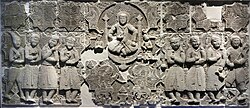This article has multiple issues. Please help improve it or discuss these issues on the talk page . (Learn how and when to remove these messages)
|
| History of the Turkic peoples pre–14th century |
|---|
 |
Turkic history is the systematic documentation and study of events involving the Turkic peoples.
Contents
- Origins
- The beginning of Turkic history
- 4th century
- 5th century
- Middle Ages/Turks
- 6th century
- 7th century
- Central Asia
- Eastern Europe
- 8th century
- Inner Asia
- Eastern Europe 2
- 9th century
- Central Asia 2
- Eastern Europe 3
- Asia and Africa
- 10th century
- Central Asia 3
- Eastern Europe 4
- Asia and Africa 2
- 11th century
- Central Asia 4
- Eastern Europe 5
- Asia
- South Asia
- 12th century
- Asia 2
- Iran and Central Asia
- South Asia 2
- Eastern Europe 6
- 13th century
- Asia and the Middle East
- Central Asia 5
- South Asia 3
- 14th century
- 15th century
- Modern era (1500 AD – present)
- 16th century
- 17th century
- 18th century
- 19th century
- 20th century
- 21st century
- Notes
- Turkish books
- English and foreign books
- See also
- References
- Sources















